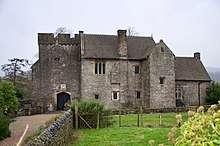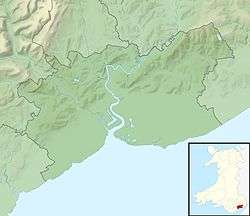Penhow Castle
Penhow Castle, Penhow, Newport dates from the early 12th century. Extended and reconstructed in almost every century since, it has been claimed to be the oldest continuously-inhabited castle in Wales. The castle is a Grade II* listed building.
| Penhow Castle | |
|---|---|
 | |
| Type | Castle |
| Location | Penhow, Newport |
| Coordinates | 51.6137°N 2.8337°W |
| Built | 12th century onwards |
| Architectural style(s) | castellated |
| Governing body | Privately owned |
Listed Building – Grade II* | |
| Official name: Penhow Castle | |
| Designated | 1 March 1963 |
| Reference no. | 3078 |
Listed Building – Grade II | |
| Official name: Barn to south-west of Penhow Castle | |
| Designated | 24 February 1976 |
| Reference no. | 3056 |
Listed Building – Grade II | |
| Official name: L-shaped Byre Range to south-west of Penhow Castle | |
| Designated | 24 February 1976 |
| Reference no. | 17079 |
Listed Building – Grade II | |
| Official name: Stable Block to far south-west of Penhow Castle | |
| Designated | 19 December 1995 |
| Reference no. | 17081 |
Listed Building – Grade II | |
| Official name: Five bay Barn and attached Byre to far south-west of Penhow Castle | |
| Designated | 19 December 1995 |
| Reference no. | 17080 |
 Location of Penhow Castle in Newport | |
History
The manor of Penhow was held by Caradog ap Gruffydd, prince of Gwent at the time of the Norman invasion of Wales.[1] The estate was seized by the Seymour family (anciently de St. Maur) and by 1129, Sir Roger de St Maur had built a fortified manor at the site. The house was extended and further fortified in the 15th and 17th centuries.[1] In the 16th century the manor passed to the Somersets. In 1674, it was purchased by the Lewis family of St Pierre.[2] Viscount Rhondda, an industrialist and conservator of ancient buildings in Wales, bought the castle in 1914.[3] By the mid-20th century, the castle was in a state of some dilapidation, until bought and restored by the film director Stephen Weeks.[4] During his tenure the castle was open to the public, while also serving as Weeks’ residence. In 2002 it was sold and reverted to a private home.[5] Penhow is frequently claimed to be the oldest continuously inhabited castle in Wales.[lower-alpha 1][7][4]
Architecture and description
The architectural historian John Newman, in his Gwent/Monmouthshire Pevsner, describes Penhow as "small and [un]convincingly defensive".[8] It is constructed of local Old red sandstone rubble.[1] The oldest portion of the castle is the west tower, which dates from the time of the Seymours. The two-storeyed hall range is later, of the 14th-15th centuries.[8] Further large-scale remodelling took place in the 17th and 18th centuries, when the castle was refashioned as a comfortable country house. The Cadw listing records notes the "exceptionally fine Restoration period interiors”. The castle is listed Grade II*.[1]
Two ranges of ancillary buildings contain some important agricultural structures, each with their own listings; the grouping immediately to the south-west of the castle includes a barn[9] and a byre.[10] The grouping farther from the castle to the south includes another barn,[11] a further byre[12] and a stable block.[13]
Notes
- John Newman suggests Cardiff Castle, Fonmon Castle and St Donat's Castle as alternative claimants.[6]
References
- Cadw. "Penhow Castle (Grade II*) (3078)". National Historic Assets of Wales. Retrieved 22 March 2020.
- "Penhow Castle". www.castlewales.com. Castles of Wales. Retrieved 22 March 2020.
- "Penhow Castle (The Gatehouse Record)". www.gatehouse-gazetteer.info. The Gatehouse Gazetteer. Retrieved 22 March 2020.
- Staff writer (16 April 2003). "Has Penhow Castle got American owners?". www.southwalesargus.co.uk. South Wales Argus.
- "Castle closes gates to visitors". BBC News. December 31, 2002. Retrieved 22 March 2020 – via news.bbc.co.uk.
- Newman 1995, p. 552.
- "Penhow Castle". www.castlexplorer.co.uk. Castles of England, Scotland & Wales. Archived from the original on 14 April 2015. Retrieved 25 May 2018.
- Newman 2000, pp. 464-465.
- Cadw. "Barn to south-west of Penhow Castle (Grade II) (3056)". National Historic Assets of Wales. Retrieved 22 March 2020.
- Cadw. "L-shaped Byre Range to south-west of Penhow Castle (Grade II) (17079)". National Historic Assets of Wales. Retrieved 22 March 2020.
- Cadw. "Five bay Barn and attached Byre to far south-west of Penhow Castle (Grade II) (17080)". National Historic Assets of Wales. Retrieved 22 March 2020.
- Cadw. "L-shaped Byre Range to far south-west of Penhow Castle (Grade II) (17082)". National Historic Assets of Wales. Retrieved 22 March 2020.
- Cadw. "Stable Block to far south-west of Penhow Castle (Grade II) (17081)". National Historic Assets of Wales. Retrieved 22 March 2020.
Sources
- Newman, John (1995). Glamorgan. The Buildings of Wales. London: Penguin Books. ISBN 9780140710564. OCLC 231881843.
- — (2000). Gwent/Monmouthshire. The Buildings of Wales. London: Penguin. ISBN 0-14-071053-1.